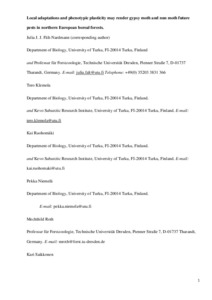Local adaptations and phenotypic plasticity may render gypsy moth and nun moth future pests in northern European boreal forests
Julia J.J. Fält-Nardmann; Tero Klemola; Kai Ruohomäki; Pekka Niemelä; Mechthild Roth; Kari Saikkonen
https://urn.fi/URN:NBN:fi-fe2021042718259
Tiivistelmä
Phenotypic plasticity and local adaptations are important factors in predicting range expansions and shifts of pest insects in a changing climate. We reared two lepidopteran forest pests, Lymantria monacha (Linnaeus) and Lymantria dispar (Linnaeus), at three climatically different field sites from central Germany to northern Finland to investigate differences among populations in plasticity in the timing of pupation and adult emergence (measured as cumulative temperature sums, degree-days >5 °C), pupal mass, and duration of the pupal period. We also compared the phenologies of continental and boreal L. monacha populations feeding on Scots pine (Pinus sylvestris L.) to reveal possible local adaptations. Lymantria dispar was reared on different host plants, Quercus robur L., Betula pendula Roth, and Betula pubescens ssp. czerepanovii (Orl.) Hämet-Ahti, to evaluate the possibilities of a range expansion northwards. There was stronger indication of adaptive phenotypic plasticity, which enables species to cope with changing environmental conditions, in continental L. dispar and boreal L. monacha populations than in the continental L. monacha population. Differences between boreal and continental L. monacha populations may denote adaptation to local conditions. All three host plants used for L. dispar proved suitable for the species, revealing that host plant availability would not limit its range expansion in northern Europe.
Kokoelmat
- Rinnakkaistallenteet [27094]
